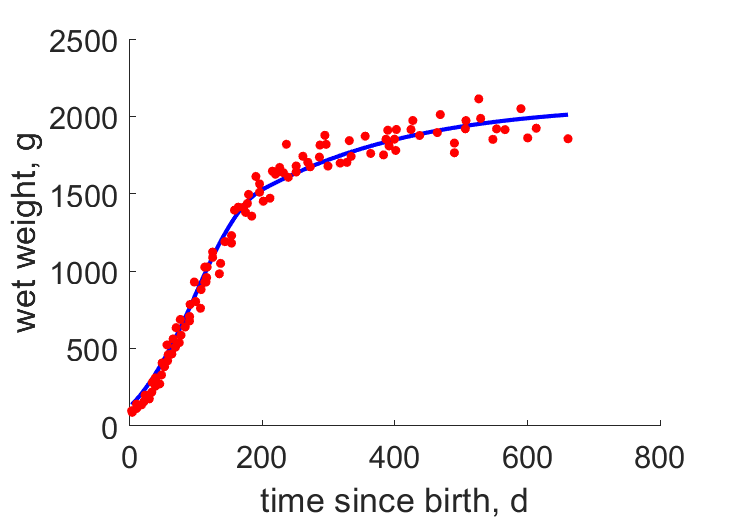Predictions & Data for this entry
| Model: std | climate: Aw | migrate: | phylum: |
| COMPLETE = 2.5 | ecozone: TN | food: biCi, biHs | class: |
| MRE = 0.025 | habitat: 0iTf | gender: Dg | order: |
| SMSE = 0.001 | embryo: Tnpf | reprod: O | family: |
Zero-variate data
| Data | Observed | Predicted | (RE) | Unit | Description | Reference |
|---|---|---|---|---|---|---|
| ab | 35 | 36.52 | (0.04343) | d | age at birth | HoyoKirw2020 |
| tx | 4.5 | 4.504 | (0.0007971) | d | time since birth at fledging | guess |
| tp | 365 | 373.4 | (0.02314) | d | time since birth at fledging | HoyoKirw2020 |
| tR | 1460 | 1460 | ( 0) | d | time since birth at 1st brood | HoyoKirw2020 |
| am | 6935 | 6889 | (0.006583) | d | life span | Gonz1995 |
| Wwb | 107.7 | 106.3 | (0.01261) | g | wet weight at birth | Corn2009 |
| Wwi | 1940 | 1941 | (0.0004931) | g | ultimate wet weight | Corn2009 |
| Wwim | 2212 | 2208 | (0.001627) | g | ultimate wet weight of male | Corn2009 |
| Ri | 0.005479 | 0.005572 | (0.01681) | #/d | maximum reprod rate | Corn2009 |
Uni- and bivariate data
| Data | Figure | Independent variable | Dependent variable | (RE) | Reference |
|---|---|---|---|---|---|
| tW |  | time since birth | wet weight | (0.05132) | Corn2009 |
Pseudo-data at Tref = 20°C
| Data | Generalised animal | Oreophasis derbianus | Unit | Description |
|---|---|---|---|---|
| v | 0.02 | 0.05924 | cm/d | energy conductance |
| p_M | 18 | 20.54 | J/d.cm^3 | vol-spec som maint |
| k_J | 0.002 | 0.0008539 | 1/d | maturity maint rate coefficient |
| k | 0.3 | 0.3044 | - | maintenance ratio |
| kap | 0.8 | 0.94 | - | allocation fraction to soma |
| kap_G | 0.8 | 0.7998 | - | growth efficiency |
| kap_R | 0.95 | 0.95 | - | reproduction efficiency |
Discussion
- Body temperature is guessed
- Males are assumed to differ from females by {p_Am} only
- mod_1: Pseudo-data point k is used, rather than k_J; Data set tp and parameter t_R are added, the latter replacing clutch interval t_N. Postnatal T is based on PrinPres1991, see get_T_Aves. See further the revision page, theme puberty
Bibliography